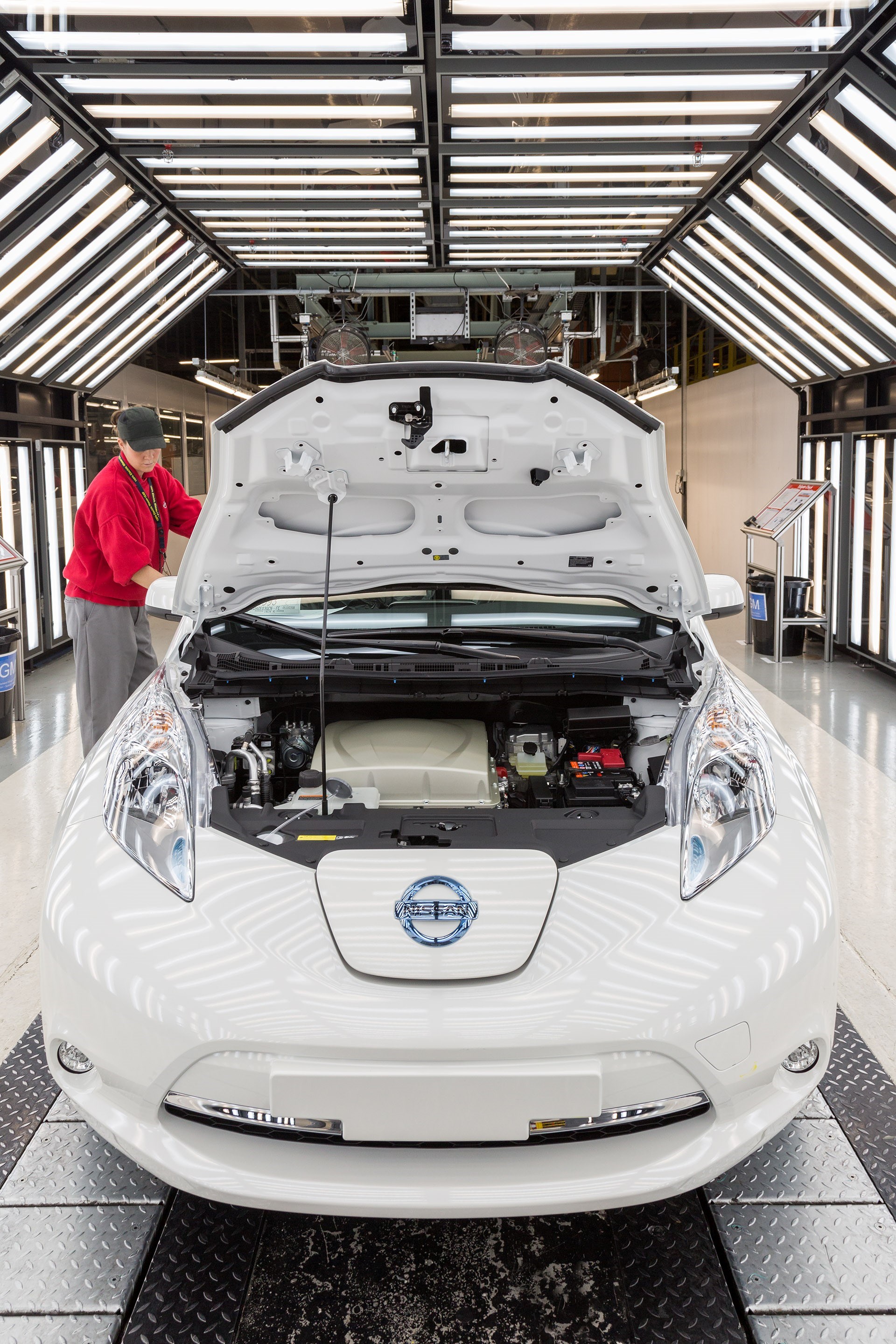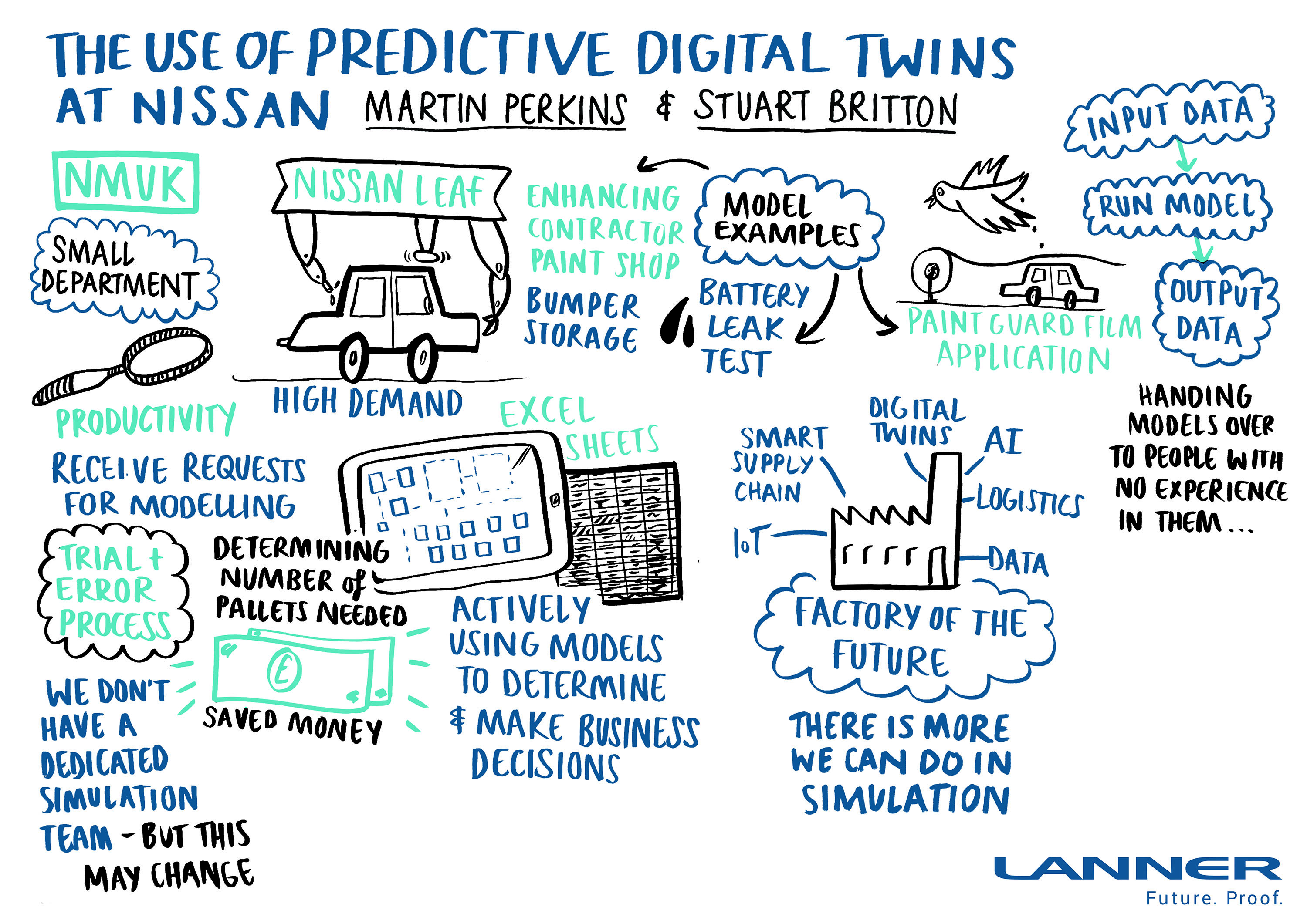- By Lanner
- In Customer Stories
- Posted 21/08/2018
Nissan Motor Manufacturing UK has been developing predictive digital twins to boost plant efficiency and optimise its business decision-making for several years. This blog showcases 5 examples of how, using Lanner’s predictive simulation software, WITNESS Horizon, industrial engineers have created models to answer key operational and strategic questions – and to help facilitate Nissan’s journey into Industry 4.0.
1. Meeting New Powertrain Production Targets
The Challenge: Identify the required process improvements that can double production rates
Nissan was preparing to launch an updated model of its Leaf electric car, featuring a new, more advanced motor. To meet projected consumer demand, the factory needed to double its powertrain throughput, from 5 jobs per hour to 10. The industrial engineering team wanted to identify potential bottlenecks with an updated production design, homing in on the process improvements that would be required to facilitate the increased output.
The Outcome: Evidence-based decision-making helps hit targets
Using predictive simulation, the team identified a crucial bottleneck in the sealing process. Once the seal is put on the motor unit, it has to cure for 15 minutes before it can be leak tested. Even after modelling several change scenarios, this blockage still couldn’t be eliminated.
To overcome the issue, engineers used the model to experiment with various countermeasures. The solution was to implement another loop that provides additional powertrain unit storage capacity. This increased throughput while still providing the required cure time before seal testing.
Nissan is now using this model for additional planning, running scenarios that facilitate 15 jobs per hour to be ready for future production ramp-up.

Nissan Leaf being built in Sunderland
2. Understanding Leak Test Failure Rates
The Challenge: De-risking production during the battery tree leak test stage
Another element of planning for the new Leaf involved analysing the leak testing process for the battery tree. The team wanted to know the maximum allowable leak test failure rate that would still result in hitting performance targets.
The Outcome: Accurate knowledge helped fulfill demand and meet KPIs
The predictive digital twin was used to model production scenarios with varying leak test failure rates. It concluded that the failure rate could not exceed 5.2% without affecting throughput. This has allowed engineering teams to plan effectively to fulfill demand.
3. Achieving a More Cost-Efficient Cylinder Head Machining Process
The Challenge: Minimising pallet requirements without affecting throughput
As part of vehicle manufacture, cylinder heads undergo a process of machining, cleaning and then second-stage machining. For part of this time, the head is attached to a pallet. Nissan's engineers were planning to order new pallets but with a significant cost for each, they wondered if the facility could operate with a reduced number without negatively affecting the current throughput rates.
The Solution: £22,000 savings on pallet procurement
The Digital Twin of the cylinder head machining line was used to run various scenarios for different pallet volumes, analysing factors such as inputs, tack time and volumes. The model showed that the minimum viable stock of 70 pallets would be required to operate at full capacity and little risk of bottlenecks, significantly less than the anticipated 100. The benefits equated to an overall savings of £22,000.
4. Reducing Bottlenecks in the Bumper Paint Facility
The Challenge: Determining the optimum storage scenario
The Sunderland plant’s bumper paint facility receives components from 2 production lines, managing to process parts for multiple car models and the wide range of paint colours. Bottlenecks were starting to occur because the facility was regularly running out of storage rack space. Engineering wanted to know how many racks were required to avoid having to stop the paint line.
The Outcome: Effective long-term planning that maintains throughput
Using a digital twin of the bumper paint line, developed using WITNESS Horizon software, Nissan created a visual model connected to spreadsheet production data. The predictive digital twin ran various scenarios based on the different car models arriving into the paint shop and determined the optimum number of storage racks to ensure neither production line would be at risk of stopping. The planning department has now evolved the digital twin to account for new vehicle release plans so that requirements can be optimised on a continual basis.
5. Analysing the Investment Case for Expansion
The Challenge: Determining whether the facility needed to invest in a new paint guard film station
Paint guard film is applied to certain car panels depending on destination and application, in order to protect the finish and increase durability. In preparation for launching the new Infiniti model, the trim and chassis engineering team were concerned that a new paint guard film station might be required in order to meet the planned demand.
The Outcome: £25,000 savings on capital expenditure
A predictive digital twin was used to simulate the production control schedule. The team ran scenarios for paint guard film requirements and determined that the existing facilities had enough capacity to cope with the projected increase in demand. A solution to cope using the existing equipment meant that capital expenditure in a new station, which would have required a £25,000 investment, was avoided with confidence.

“We’re quite a lean department and working with Lanner, and WITNESS, has helped us develop models which are now used regularly to make business decisions across Nissan in the UK. Thanks to the modelling, we’ve been able to implement steady improvements in our processes, and simulation has become a key part of Nissan’s adoption of Industrial IoT and smart technology.” - Martin Perkins, Industrial Engineer, Nissan Motor Manufacturing UK
